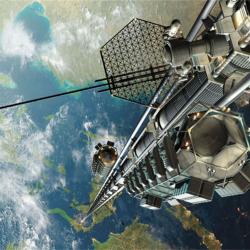Source Institutions
Source Institutions
Add to list Go to activity
Activity link broken? See if it's at the internet archive

In this activity, learners imagine what the world might look like if we could build an elevator to space! After viewing some artist illustrations of possible space elevators, learners imagine what our future world might be like if it were possible to take an elevator into space. Learner draw and talk about what they image, while reflecting on and discussing several suggested questions in the activity guide. The activity makes connections to the field of nanotechnology through the possibilities of nanomaterials changing our future, and how people’s values shape how nanotechnologies are developed and adopted. Step-by-step instructions are included with photos along with safety recommendations. Activity guide includes a "What's going on?" explanation and quick connections to space exploration and super strong, lightweight carbon nanotubes.
- Under 5 minutes
- 10 to 30 minutes
- 1 cent - $1 per student
- Ages 4 - adult
- Activity
- English
Quick Guide
Materials List (per student)
- Paper
- Markers (or other drawing tools)
- Images of artist renditions of Space Elevators (optional)
Subjects
-
Earth and Space Science
-
Astronomy
- Probes, Satellites and Spacecraft
-
Astronomy
-
Engineering and Technology
-
Engineering
- Metallurgy and Materials Engineering
- Nanotechnology
-
Technology
- Construction
-
Engineering
-
The Nature of Science
- Science and Society
-
The Nature of Technology
-
Technology and Society
- Impacts of Technology
-
Technology and Society
Audience
Learning styles supported:
- Involves teamwork and communication skills
- Links STEM to other topics of interest such as arts and humanities
- Involves hands-on or lab activities
Other
Components that are part of this resource:
This resource is part of:
- Do It Yourself Nano activities and experiments
- DIY Nano HD
- DIY Nano e-book with photos and activities
Access Rights:
- Free access
By:
- Sciencenter
Source Collection
- NISE Network
Rights:
- , Sciencenter, 2013
Funding Source:
- National Science Foundation
